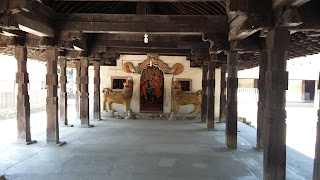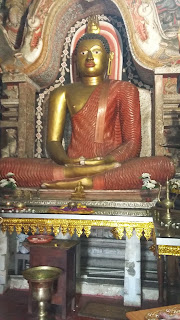Day 17 Joshua 2:19 - Judges 14:9
The three temples loop.
The countryside around the Kandy is dotted with dozens of historic Kandyan-era temples most of them still largely unvisited by foreign visitors. The most interesting are the Embekke, Lankatilake and Gagaladeniya, which lie some 10km west of Kandy and make for a rewarding half day walk know popularly as the Three temples loop, though to be fair it's actually more of a straight line rather than a loop, however, I duly booked my tuc-tuc to take me to the first of the temples with my intention of walking to the other two and then returning again on foot to the Theological College.
Embekke Devale.
Dating from the 14th century the rustic little Buddhist temple Embekke Devale dedicated to Kataragama, (a pilgrimage town dedicated to the Buddah) is famous principally for the fine Pavilion, the Digge, (drummer boys pavilion) fronting the main shrine (you can Google for more information! ) The principal area of interest concerning the pavilion are the many decorative panels depicting a variety of animals, entwined swans, wrestlers, dragons, dancers horseman and soldiers one of the most famous panels depicts and elephant and lion fighting.
From Embekke Devale I leave the village via a sharp incline and a large bo tree and paddy fields,
after a kilometre and half or so over the brow of a hill I catch a glimpse of the Lankatilake almost obscured by trees on the steep hillock ahead.
Approaching the base of the hill from where a magnificent flight of ancient thick-cut steps, alongside a less treacherous set of modern stone steps leads precipitously up to the temple itself.
Lankatilake.
Built on a huge rock outcrop the imposing Lankatilake is perhaps the finest temple in the district. Founded in1344, its architecture is reminiscent of the solid gedige-style stone temples, rather than the later and more decorative the style wooden temples. The gloomy central shrine, with 18C paintings, us manically atmospheric, filled with a great seated Buddha under a huge makara torana (dragon arch) with tiers of gods rising above.
The external shrines sadly locked though you can see carvings of elephants on the exterior walls.
This temple interestingly also shares the rock and the main building with a Hindu temple approached from the opposite end, entering the temple we were ushered behind a curtain into the temple proper, a square building and on each face alcoves had been created in which sat the Hindu gods.
Returning down the steep steps I pick up the road and follow to the village of Pamunuwa and then onto the Gagaladeniya temple around 3km.
Gagaladeniya
Dates from the same year-1344 -as Lankatilake. The principle shrine is built on a rock outcrop at the top end of the site, the carvings of dancers and drummers on the roof have a pronounced South Indian flavour having been designed by a Tamil architect.
The interior houses a fine gold Buddha, again under a marvellous dragon arch.
Leaving the temple I continue along the road another half km or so past a local weavers and a sub post office
to reach the busy town of Pilimathalawa on the main Colombo – Kandy highway, I turn right for the 2km walk back to the college, stopping enroute for a refreshing orange flavoured ice lolly at 10 rupees about 4 of our English pennies.
The entrance fee for each temple 300 rupee, which you've already calculated as being around £1.20 (National Trust take note) seemed reasonable, then you're reminded that's tourist Sri Lankan nationals pay 50, and why not.
Extracted from "The rough guide"
Today I invite your prayers for the work that continues between different faith leaders in Sri Lanka.
The three temples loop.
The countryside around the Kandy is dotted with dozens of historic Kandyan-era temples most of them still largely unvisited by foreign visitors. The most interesting are the Embekke, Lankatilake and Gagaladeniya, which lie some 10km west of Kandy and make for a rewarding half day walk know popularly as the Three temples loop, though to be fair it's actually more of a straight line rather than a loop, however, I duly booked my tuc-tuc to take me to the first of the temples with my intention of walking to the other two and then returning again on foot to the Theological College.
Embekke Devale.
Dating from the 14th century the rustic little Buddhist temple Embekke Devale dedicated to Kataragama, (a pilgrimage town dedicated to the Buddah) is famous principally for the fine Pavilion, the Digge, (drummer boys pavilion) fronting the main shrine (you can Google for more information! ) The principal area of interest concerning the pavilion are the many decorative panels depicting a variety of animals, entwined swans, wrestlers, dragons, dancers horseman and soldiers one of the most famous panels depicts and elephant and lion fighting.
From Embekke Devale I leave the village via a sharp incline and a large bo tree and paddy fields,
after a kilometre and half or so over the brow of a hill I catch a glimpse of the Lankatilake almost obscured by trees on the steep hillock ahead.
Approaching the base of the hill from where a magnificent flight of ancient thick-cut steps, alongside a less treacherous set of modern stone steps leads precipitously up to the temple itself.
Lankatilake.
Built on a huge rock outcrop the imposing Lankatilake is perhaps the finest temple in the district. Founded in1344, its architecture is reminiscent of the solid gedige-style stone temples, rather than the later and more decorative the style wooden temples. The gloomy central shrine, with 18C paintings, us manically atmospheric, filled with a great seated Buddha under a huge makara torana (dragon arch) with tiers of gods rising above.
The external shrines sadly locked though you can see carvings of elephants on the exterior walls.
This temple interestingly also shares the rock and the main building with a Hindu temple approached from the opposite end, entering the temple we were ushered behind a curtain into the temple proper, a square building and on each face alcoves had been created in which sat the Hindu gods.
Returning down the steep steps I pick up the road and follow to the village of Pamunuwa and then onto the Gagaladeniya temple around 3km.
Gagaladeniya
Dates from the same year-1344 -as Lankatilake. The principle shrine is built on a rock outcrop at the top end of the site, the carvings of dancers and drummers on the roof have a pronounced South Indian flavour having been designed by a Tamil architect.
The interior houses a fine gold Buddha, again under a marvellous dragon arch.
Leaving the temple I continue along the road another half km or so past a local weavers and a sub post office
to reach the busy town of Pilimathalawa on the main Colombo – Kandy highway, I turn right for the 2km walk back to the college, stopping enroute for a refreshing orange flavoured ice lolly at 10 rupees about 4 of our English pennies.
The entrance fee for each temple 300 rupee, which you've already calculated as being around £1.20 (National Trust take note) seemed reasonable, then you're reminded that's tourist Sri Lankan nationals pay 50, and why not.
Extracted from "The rough guide"
Today I invite your prayers for the work that continues between different faith leaders in Sri Lanka.













Comments
Post a Comment